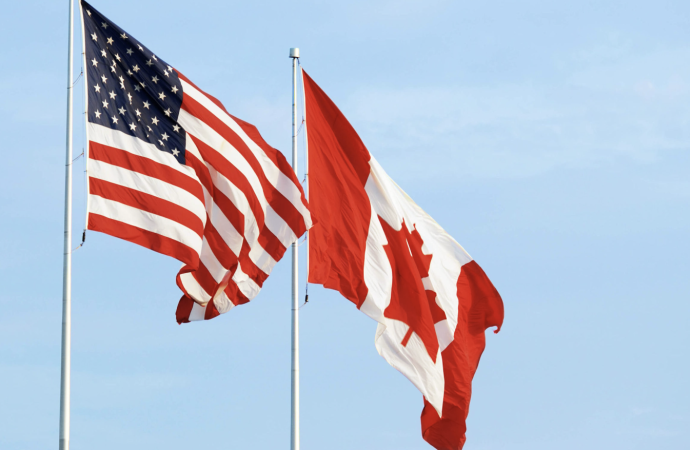Canada vs. United States: Which is the Better Choice for Immigration in 2025? Deciding between Canada and the United States for immigration is a significant choice, shaped by factors like economic opportunities, quality of life, and long-term residency options. Both countries have long been popular destinations for immigrants seeking stability and prosperity, but their immigration

Canada vs. United States: Which is the Better Choice for Immigration in 2025?
Deciding between Canada and the United States for immigration is a significant choice, shaped by factors like economic opportunities, quality of life, and long-term residency options. Both countries have long been popular destinations for immigrants seeking stability and prosperity, but their immigration policies and frameworks differ. As Canada unveils its 2025–2027 Immigration Levels Plan and the U.S. considers potential reforms under “Project 2025,” the debate continues to evolve. This article compares the key aspects of both countries’ immigration systems, costs, and social factors to help you make an informed decision.
Canada’s Immigration Strategy (2025–2027)
On October 24, 2024, Canada’s Immigration, Refugees and Citizenship Canada (IRCC) presented its new Immigration Levels Plan. The highlights include:
Permanent Resident Admissions
- 2025: Target of 395,000 new permanent residents
- 2026: Decrease to 380,000
- 2027: Further reduction to 365,000
This marks a shift from the original goal of admitting 500,000 immigrants annually by 2025. The Canadian government cites the pressure on infrastructure, such as housing and healthcare, as reasons for lowering these targets. Immigration Minister Marc Miller emphasized the importance of a “managed migration system” to ensure successful integration.
Economic Immigration Focus
By 2027, 62% of the admissions will be focused on economic categories, prioritizing industries like healthcare, skilled trades, and technology. Canada’s Express Entry system remains central, now working alongside the Provincial Nominee Program (PNP) to meet regional labor needs.
Temporary Resident Admissions
- 2025: 673,650 new temporary residents
- 2026: 516,600
- 2027: 543,600
Canada’s efforts to balance the influx of temporary workers and international students with its capacity constraints are reflected in these numbers.
Key Takeaway: Canada is adjusting its immigration levels to ensure newcomers can integrate effectively into the workforce and society. The emphasis on economic categories aligns with national labor market demands, while still welcoming family reunification and humanitarian entrants.
U.S. Immigration Under “Project 2025”
Former President Donald Trump has proposed an immigration reform agenda, often referred to as “Project 2025,” which focuses on stricter enforcement measures:
Key Proposals Include:
- Ideological Screening: Stricter checks on applicants with extremist views, including social media reviews.
- Naval Blockades: Using the Coast Guard and Navy to stop drug-smuggling vessels in international waters, extending border controls offshore.
- Mass Deportations: Expedited removal of undocumented immigrants, especially those with violent criminal records.
- Ending Birthright Citizenship: A reinterpretation of the 14th Amendment to prevent automatic citizenship for children of non-citizens.
- Enhanced Border Security: Reinstituting the “Remain in Mexico” policy and building more physical barriers on the southern border.
- Restructuring Immigration Agencies: Proposals to overhaul the Department of Homeland Security (DHS) and consolidate agencies like ICE, CBP, and USCIS.
The U.S. approach under Project 2025 emphasizes deterrence, stricter enforcement, and faster deportations, which may reduce some pathways to legal status. However, many of these proposals, such as ending birthright citizenship, will face legal and legislative challenges.
Comparison of Immigration Programs
Canada’s Immigration Programs
- Express Entry System: A points-based system that evaluates skilled workers based on age, education, work experience, and language proficiency.
- Provincial Nominee Program (PNP): Allows provinces to nominate individuals to meet local labor market needs.
- Family Sponsorship: Citizens and permanent residents can sponsor family members for immigration.
- Post-Graduation Work Permit (PGWP): International students can stay and work after graduation, often leading to permanent residency.
- Refugee Programs: Canada continues to offer resettlement opportunities for refugees, demonstrating a commitment to humanitarian causes.
United States’ Immigration Programs
- Green Cards: Available through family sponsorship, employment, or the Diversity Visa Lottery.
- H-1B Visa: For specialized workers, though it’s competitive with annual caps.
- F-1 Student Visa: Allows international students to study and work temporarily under the OPT program.
- Asylum/Refugee Programs: The U.S. admits refugees, though the numbers fluctuate each year.
- EB-5 Investor Program: Requires a significant investment in a U.S. business to create jobs and gain residency.
The U.S. immigration system is more complex, with fewer clear pathways to permanent residency. While family-based and employment-based routes are common, the processes can be lengthy and unpredictable.
Work Opportunities and Economic Potential
Canada
- Labor Shortages: Despite a smaller population, Canada has significant labor shortages, especially in healthcare, IT, construction, and engineering.
- Easier Integration: Canada’s recognition of high-demand skills and emphasis on immigration for skilled workers helps newcomers integrate into the job market.
- Cost of Living: While housing in cities like Toronto and Vancouver is expensive, government support and relatively high wages make it manageable for many immigrants.
United States
- Vast Economy: As the largest economy in the world, the U.S. offers diverse job opportunities across nearly every industry, including tech, finance, and entertainment.
- Higher Salaries: Salaries in certain fields, particularly in tech and finance, can be much higher in the U.S. than in Canada.
- Competitive Labor Market: Immigrants often face more competition for work visas and jobs, especially in regulated industries.
Both countries offer robust job markets, but Canada’s targeted focus on addressing labor shortages in specific sectors makes it easier for skilled immigrants to find employment. The U.S. offers higher salary potential but with more competition and regulatory hurdles.
Quality of Life: Healthcare, Education, and Social Services
Canada
- Universal Healthcare: Canada’s public healthcare system covers all residents, although wait times for certain procedures can be long.
- Education: Public education is highly regarded, and post-secondary education is more affordable compared to the U.S.
- Social Services: Canada offers strong social support systems, including paid parental leave, childcare subsidies, and a high quality of life with safe, clean cities.
United States
- Healthcare: The U.S. has advanced healthcare, but it can be expensive without employer-provided insurance or private plans.
- Education: Higher education in the U.S. can be prestigious but comes with a high price tag.
- Cost of Living: Housing costs can vary significantly across the country, from expensive metro areas to more affordable regions.
For those who prioritize affordable healthcare and strong social welfare, Canada stands out. The U.S. offers more prestigious educational opportunities, but these often come with a high cost.
Pathway to Citizenship and Residency
Canada
- Permanent residents can apply for citizenship after living in Canada for three out of five years.
- Dual citizenship is allowed, and the process for transitioning from temporary to permanent status is more straightforward.
United States
- Green card holders can apply for citizenship after five years, or three years if married to a U.S. citizen.
- The path to citizenship can be lengthy, with occasional delays and extended backlogs in certain visa categories.
Canada offers a quicker and more predictable route to citizenship, while the U.S. path can be more complex and time-consuming.
Cost of Immigration and Living
Canada
- Application fees for Canada’s immigration programs, such as Express Entry and PNP, are relatively modest.
- Housing in major cities like Toronto and Vancouver can be expensive, but services like healthcare help reduce living costs.
- Canada is known for its family-friendly environment with subsidies for childcare and education.
United States
- Immigration application fees can be high, particularly for programs like the EB-5 investor visa.
- Living costs in major U.S. cities like New York and San Francisco can be as high as, or higher than, Canadian cities, though smaller towns are more affordable.
- Healthcare costs are a significant factor in monthly expenses, with many people relying on employer-based or private insurance.
Looking Ahead: Immigration Trends for 2025
Canada is adjusting its immigration targets to ensure newcomers can be successfully integrated into society, with an emphasis on economic categories. Meanwhile, the U.S. is proposing stricter measures under “Project 2025,” which could significantly alter its immigration landscape, though many of these changes will face legal challenges.
Final Thoughts: Which Country Is Right for You?
Canada
- Pros: Transparent immigration system, universal healthcare, strong social welfare programs, and a focus on skilled workers.
- Cons: Higher housing costs in major cities and fewer immediate job opportunities compared to the U.S.
United States
- Pros: A larger economy, higher salary potential, and a broad range of job opportunities.
- Cons: A complex immigration process, expensive healthcare, and unpredictable policy shifts.
Ultimately, the best choice between Canada and the U.S. depends on your personal goals. If you value a smoother, more predictable immigration process and robust social services, Canada might be the better option. However, if you’re seeking higher earning potential and diverse career opportunities, the U.S. could be the right fit, provided you can navigate its more complex immigration system. Both countries offer tremendous opportunities, but it’s essential to weigh each country’s advantages and challenges based on your own needs and circumstances.

















Leave a Comment
Your email address will not be published. Required fields are marked with *